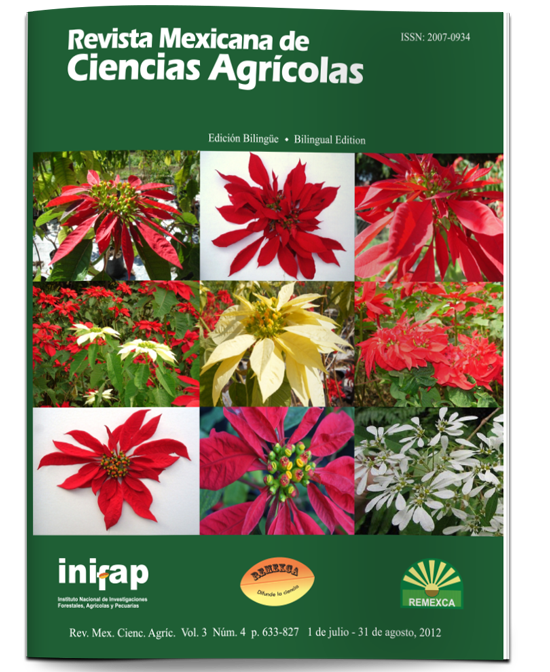Resistance of four population mites (Tetranychus urticae Koch.) to propargite in cut rose (Rosa x hybrida) in the State of Mexico, Mexico
DOI:
https://doi.org/10.29312/remexca.v3i4.1431Keywords:
spider mites, bioassay, Potter towerAbstract
The spider mite, Tetranychus urticae Koch., is one of the most important pests of cut rose (Rosa x hybrida) in the State of Mexico and, its primary control it ́s through the use of acaricides, such as propargite; the producers initially used it with satisfactory results and currently it does not control this pest anymore. In order to estimate the level of resistance to that acaricide, in 2007, its response to this acaricide was assessed in populations from Coatepec Harinas, Tenancingo, Villa Guerrero and Zumpahuacán, State of Mexico. In each locality at least 4 000 nymphs and 2 000 adults were collected in the cut rose cultivation in greenhouses and were reproduced to F1 for the bioassays. The dose range that eliminated 0 to 100% of the treated individuals was determined (biological window). Subsequently, from five to seven concentrations were included covering the range. Five repetitions were made, four in different consecutive days. Spider mite populations from Coatepec Harinas (RR95= 7.9X, Villa Guerrero (RR95= 1.3X and Zumpahuacán (RR95= 11X) are considered susceptible to propargite; while the population of Tenancingo (RR95= 90.1X) is considered resistant to the acaricide.
Downloads
Downloads
Published
How to Cite
Issue
Section
License
The authors who publish in Revista Mexicana de Ciencias Agrícolas accept the following conditions:
In accordance with copyright laws, Revista Mexicana de Ciencias Agrícolas recognizes and respects the authors’ moral right and ownership of property rights which will be transferred to the journal for dissemination in open access. Invariably, all the authors have to sign a letter of transfer of property rights and of originality of the article to Instituto Nacional de Investigaciones Forestales, Agrícolas y Pecuarias (INIFAP) [National Institute of Forestry, Agricultural and Livestock Research]. The author(s) must pay a fee for the reception of articles before proceeding to editorial review.
All the texts published by Revista Mexicana de Ciencias Agrícolas —with no exception— are distributed under a Creative Commons License Attribution-NonCommercial 4.0 International (CC BY-NC 4.0), which allows third parties to use the publication as long as the work’s authorship and its first publication in this journal are mentioned.
The author(s) can enter into independent and additional contractual agreements for the nonexclusive distribution of the version of the article published in Revista Mexicana de Ciencias Agrícolas (for example include it into an institutional repository or publish it in a book) as long as it is clearly and explicitly indicated that the work was published for the first time in Revista Mexicana de Ciencias Agrícolas.
For all the above, the authors shall send the Letter-transfer of Property Rights for the first publication duly filled in and signed by the author(s). This form must be sent as a PDF file to: revista_atm@yahoo.com.mx; cienciasagricola@inifap.gob.mx; remexca2017@gmail.
This work is licensed under a Creative Commons Attribution-Noncommercial 4.0 International license.



